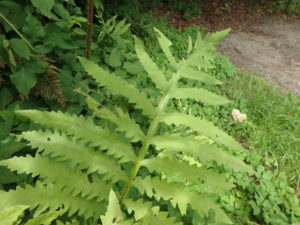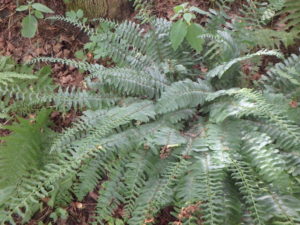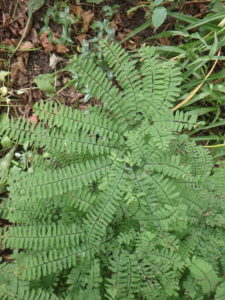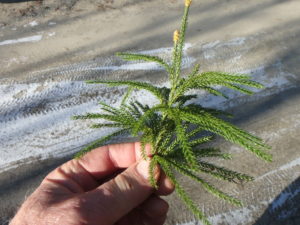Learning How to Identify 8 Common Ferns
Ferns are under-rated and largely ignored by gardeners, but should not be. They can add much to a garden. I recently went to Walpole, NH where I met with Michael Nerrie of Distant Hill Gardens and Nature Trail. He introduced me to many ferns and also sold me a copy of a wonderful book, Identifying Ferns the Easy Way: A Pocket Guide to Common Ferns of the Northeast by Lynn Levine. It’s published by Heartwood Press.
Unlike other books I have seen that identify ferns, this one doesn’t require you to learn a whole new vocabulary. And the illustrations and layout make learning ferns easy. There are just 28 common ferns in the book, and there are silhouettes of each at the beginning of the book. The silhouettes are divided into 6 groups based on how the leaves are “cut”. So a quick look will identify most ferns, and the straightforward descriptions quickly confirm which fern you are looking at.
Imagine a frond of a fern that is all one big blade or leaf. Then imagine taking scissors and cutting that blade into leaflets. That is Group 1, once-cut ferns. Group 2 includes ferns that are twice-cut, and then divided into 2 groups based on how the fronds (stems) are arranged, either in a vase shape or in a random arrangement. And so on. There are five thrice-cut ferns, five ferns with 3 parts instead of one long blade, and one unique fern, the maidenhair fern which is unlike all the others. Pretty straightforward. Here are 8 common ferns you can easily learn to identify. Quotations below are from Ms Levine’s book.
Group 1: Once-cut
- Christmas fern (Polystichum acrostichoides). Unlike nearly all others, this fern stays green all winter, and has very dark green leaves. It grows in free-form clusters, and has simple leaves. The leaflets have “a little bump (ear) near the stalk” and are 1 to 3 feet long.
- Sensitive Fern (Onoclea sensibilis): Light green leaves. “Leaflet pairs are opposite each other (like a bow tie).” Topmost leaflets are smooth, others have wavy edges. It is very frost-sensitive, hence the name. Often grows in big colonies, either in sun or shade. Can be a pest in the garden as it spreads by root.
Group 2A: Twice-cut, Vase-like clusters
- Interrupted Fern (Osmunda claytoniana). A big fern with fronds up to 5 feet, this will grow in wet or dry shade. When spores are produced, they interrupt the arrangement of leaflets with smaller spore-producing leaflets that are not like the other leaflets. But not all plants will have an interrupted section, so look at a colony to find some that do (to confirm I.D.). The little leaflets that produce spores get dry and turn brown in mid-summer.
- Ostrich fern (Matteuccia struthiopteris). This is the fern that produces edible fiddleheads in early spring. It has a deep groove up the middle of the stem, like celery. Other ferns may have small grooves, but nothing like this. It is big: up to 5 to 7 feet tall, and shaped like a badminton birdy (vase-shaped). It is most common in moist shade, commonly along stream banks, but will grow in shady places in the garden. Can be very dramatic as an accent plant, but does spread.
Group 2-B: Twice-cut, Random placement of stems
- Silvery glade fern (Deparia achrostichoides): Frond is “very delicate for such a tall fern”. Can grow 2 to 3 feet tall. Lowest pair of leaflets point down. But for me, the identifying characteristics is that the spore cases of the leaflets are “arranged in a herringbone pattern on their undersides”.
Group 3: Thrice-cut
- Hay-scented fern (Dennstaedtia punctilobula). If you have crushed this fern and sniffed it, it smells like fresh-cut hay. It is finely cut and stays just 1 to 3 feet tall. It is one of the few that will grow in a hot, sunny location such as a west-facing, sandy hillside, though it will grow in partial shade or rocky slopes. It spreads, and will fill in an area, making a large colony. Sold in nurseries as a ground cover.
Group 4: Leafy parts in 3 distinct sections
- Bracken fern (Pteridium aquilinum). This grows in poor or barren soil in sun or shade. May form large colonies. Grows up to 3 feet tall. The blade (leafy part) is roughly horizontal to ground in 3 triangular leaflets, each with its own stem.
Group 5: Unique
- Maidenhair fern (Adiantum pedatum). This is often sold in garden centers as it is delicate-looking but sturdy and hardy on thin black stems that look like wires. In the wild it indicates good rich soil. The blade (the leafy part) is almost horizontal and is fan-shaped.
I found Lynn Levine’s guide easy to use – and it fits in the back pocket of my jeans. At $10.95, it’s a bargain. Distant Hill Gardens is full of wonderful plants to view and buy (including ferns), so pay them a visit. Open select weekends May to October, or by appointment (www.distanthill.org). Lynn Levine’s next fern workshop will be September 29 from 1 to 3:30 at Distant Hill Garden.
Henry can be reached at henry.homeyer@comcast.net.
Five Plants for Adding Indoor Color
This is the dark time of the year. The sun sets early, and is often obscured by clouds dripping rain and snow. For that reason, I string bright lights on trees outdoors, decorate a tree indoors, place candles in my windows – and lots more. I buy cut flowers, too, but I can’t afford to buy armloads of bright flowers every week. Fortunately the outdoors provides me with many nice things to brighten my living space.
One of my favorite shrubs at this time of year is winterberry (Ilex verticillata). You may have seen the bright red berries of wild winterberry growing alongside the road in wet places, often in standing water. It favors wet places, but can be grown in the average garden. In the wild it is an understory shrub, one that grows in partial shade. It produces the most berries, however, in full sun.
As a landscape plant, the winterberry is best in fall and winter when the red berries are prominent. The spring blossoms are small and white, and hardly noticeable. These shrubs are either male or female, and you need one male for every 6 to 10 females within about a 50-foot range. So when you buy winterberry, plan on having several. Unlike puppies, you can’t lift a tail and know what sex you are buying, but have to depend on the nursery to label them properly.
When you bring cut branches into the house and place them in a vase of water you will notice that they regularly drop berries. There is a solution: spray with a clear lacquer. Last year I sprayed branches that I used on my door wreath, and for the first time ever, most berries stayed on until I took down the wreath. Previously some of the berries fell off every time the door was closed.
Evergreen boughs are commonly used for indoor arrangements, sprays, kissing balls and garlands. If you plan to harvest evergreen branches on your own property for this, be sure to use branches that will hold onto their needles. Balsam fir and spruce, commonly used for Christmas trees, hold onto their needles well even when not in a vase of water. But most of us don’t want to cut off branches if we have balsam or spruce on the property.
What most of us have growing in our woods are white pine and Canadian hemlock. White pines hold their needles, hemlocks do not. The hemlocks have short needles arranged flat along the stems; they have 2 white stripes on the underneath side of each needle. White pine needles are long and pointy, but soft. They grow in bundles of 5 needles (one for each letter in the word ‘white’).
Of the ferns you might see in the woods now, only the Christmas fern (Polystichum acrostichoides) is suitable for use in a vase. These have leathery green leaves with leaflets arranged in an alternating pattern. Some think the leaflets resemble a Christmas stocking, with a toe or heel at the end near its attachment point. I do not. I think they are called Christmas fern because they are still nice at Christmas and other ferns have largely disappeared by now.
Christmas ferns grow in shade or partial shade, and prefer somewhat moist locations. If you pick some, do not completely defoliate an individual plant. Take a few stems from one, and then a few from others. These plants are tough, but slow-growing.
What else is green and will do well indoors? Ground pine (Lycopodium obscurum) grows in deciduous forest in many of the same places as Christmas ferns. It is not a pine at all, but a club moss, a group of primitive plants that fed the dinosaurs when club mosses got to be 30 feet tall. These poor relatives only grow a few inches to a foot tall, but have handsome foliage in winter. They spread by rhizomes or roots. Each plant has leaves that come from the central spine of the plant, and lie parallel to the ground – like little Christmas trees. Please be judicious in picking these.
Back to the reds: red-twigged or redosier dogwood (Cornus sericea), a native of moist areas here in the Northeast, looks good in a vase. The color brightens up considerably in the winter, especially on this year’s growth. If the town road crew brush-hogged the roadside this summer, the new growth on red dogwood will be very bright.
Of course the plant nursery business has been working hard and breeding the reddest, brightest varieties and touting each of them as the very best. But all are good, and are very fast growing – especially in wet areas. I favor pruning out at least half the stems each year to get new stems with bright winter color, and have been known to cut a bush right to the ground.
So don’t feel bad if you can’t afford big vases of roses at this time of year. Get outside and pick some nice things that will brighten the house.
Read Henry’s blog at https://dailyuv.com/








